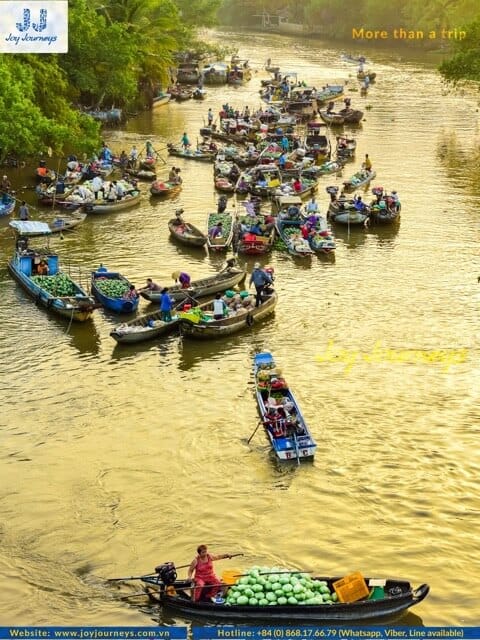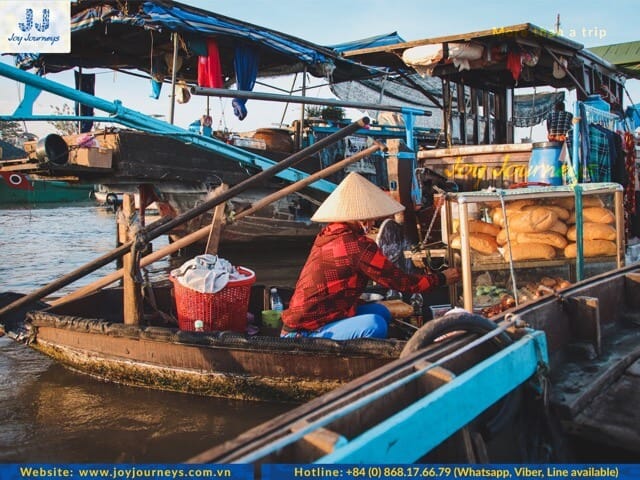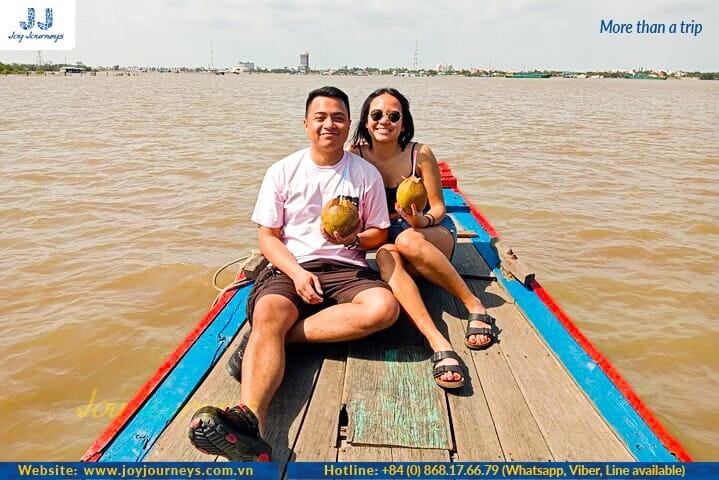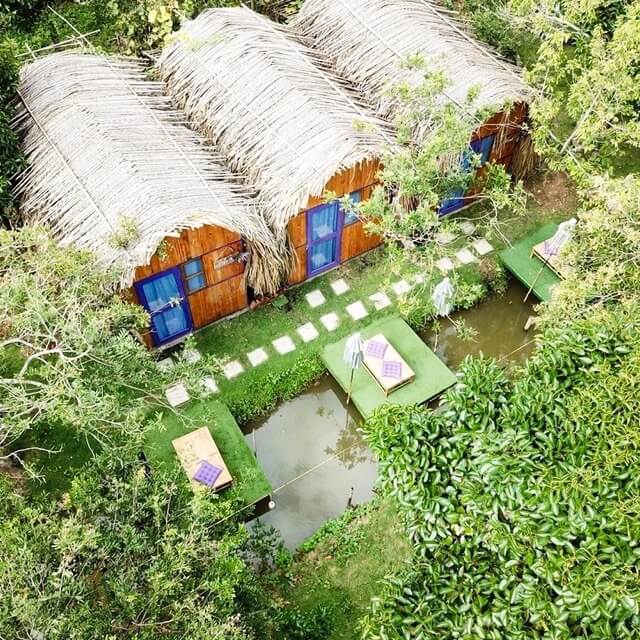Cai Be Vietnam is a small and picturesque town located in the Mekong Delta region. With its stunning floating markets and traditional architecture, Cai Be is a must-visit destination for travelers looking to explore Vietnam’s unique culture and history.
However, Cai Be has much more to offer beyond its sights. From colorful attractions to fascinating history and culture, accommodations, local shopping, and transportation details, Cai Be has something for everyone.
Are you ready to discover the magic of Cai Be? Keep reading to learn more about this fantastic destination and plan your perfect trip!
Cái Bè no longer has a floating market, but it is still an interesting and worthwhile destination for visitors to explore
Contents
Cai Be Vietnam: Uncovering a Hidden Gem in the South
Cai Be Vietnam, located in the Tien Giang Province, is a small rural town in the Mekong Delta, known for its floating markets that have been around since the 18th century. With a population of around 27,000, the town is situated on the banks of the Tien River. It is an important cultural hub in the Mekong Delta, known for its traditional music, art, and handicrafts.
In addition to exploring the lively atmosphere of the floating markets, visitors can also engage in local daily activities, visit historical landmarks and local temples, cycle through picturesque countryside, or indulge in the local cuisine.
As a vibrant hub of local commerce, the Cai Be Floating Market offers visitors various local products from vendors. The floating market in the Mekong Delta is open from 6 am-12 pm.


Visitors can further explore the area by taking boat tours and other water activities, taking in the tranquil canals and countryside scenery, and enjoying the many scenic spots and photo opportunities available.
Moreover, it is worth noting the significance of Cai Be within the Mekong Delta region, with its rich cultural heritage and notable economic development.
As such, Cai Be is a popular destination for travelers looking to explore the region’s attractions, learn its history and culture, book accommodations, shop for local products, and find transportation details.
With so much to offer, Cai Be is a must-see destination for anyone looking to discover the hidden gems of Southern Vietnam.
Travel experiences and activities in Cai Be
Cai Be, Vietnam, is a destination that offers travelers a unique and immersive experience. From exploring the vibrant floating market to engaging with locals and vendors, visitors can taste local life.
Participating in daily activities and traditions, taking a boat tour along the Mekong Delta, and cycling through the picturesque countryside are all activities that are popular among travelers.

Popular routes include:
- The Cai Be-Vinh Long-Can Tho route.
- The Cai Be-Vinh Long-Tra On route.
- The Cai Be-Vinh Long-Tra Vinh route.
Along these routes, visitors can expect to experience a myriad of activities and attractions, such as scenic spots, cultural experiences, and a variety of shops and restaurants.
You could further expand on the experiences and activities available in Cai Be, such as participating in agricultural tours to learn about and experience the local farming practices, visiting traditional craft villages, and taking part in local cooking classes to learn how to cook the unique dishes of Cai Be.
In addition, you could also explore nearby destinations such as the Tram Chim National Park and Tram Chim Eco-tourism area, where visitors can enjoy beautiful natural landscapes and outdoor activities such as fishing, hiking, and bird-watching.
Furthermore, you could highlight the unique cultural experiences available in Cai Be, such as attending traditional music and dance performances or visiting local temples and pagodas.
You could also discuss the importance of Cai Be in the Mekong Delta region and how it has contributed to the region’s rich cultural heritage and economic development. With so much to offer, Cai Be is a must-visit destination for anyone looking for an immersive and authentic travel experience in Southern Vietnam.
One of the highlights of visiting Cai Be, Vietnam, is the opportunity to indulge in the local cuisine, including fruits such as rambutan, dragon fruit, jackfruit, and traditional delicacies like banh xeo and banh cuon.
Sample the unique dishes and flavors of the region, such as the famous Cai Be sweet and sour soup, or the traditional Cai Be crispy pancake. Be sure to check out the local food markets and stalls for an authentic experience and the best in local specialties. From the fresh produce to the unique dishes, there is something for everyone in Cai Be, Vietnam!
Finding Accommodation in Cai Be
When planning your trip to Cai Be Vietnam, one of the important things to consider is finding the perfect accommodation. Fortunately, Cai Be offers a wide range of options to suit every budget and preference, from budget-friendly hotels to luxurious resorts and romantic getaways. Homestays are also available for families looking for family-friendly accommodations.

When searching for a place to stay, it’s essential to consider the amenities and facilities that are offered. Some travelers prefer a swimming pool, while others want access to free WiFi or a restaurant. It’s important to think about your budget and preferences when choosing the ideal accommodation.
For those on a budget, Cai Be has plenty of affordable options to choose from. On the other hand, travelers looking for a more luxurious experience can select from various upscale resorts. Couples seeking a romantic getaway can find many romantic resorts to choose from, while families looking for family-friendly accommodation should consider homestays.
To ensure you have the best experience possible, booking your accommodation early is vital, especially during peak seasons from October to April. Popular areas to stay in Cai Be include the Mekong Delta, the Red River Delta, and Ho Chi Minh City. When selecting your accommodation, take into account the location and proximity to attractions. You should also read reviews and recommendations from previous guests to get the most out of your stay.
Lastly, to help you find the perfect accommodation, you should know that there are different types of accommodations available in Cai Be, such as guesthouses, serviced apartments, and family-friendly resorts. With all these options, you’re sure to find the perfect place to stay in Cai Be and enjoy all the city offers!
Unique Souvenirs and Local Products
Cai Be Floating Market in Vietnam is a must-visit destination for any traveler looking for a unique shopping experience. This bustling market offers a wide variety of local products and handicrafts, from traditional clothing to decorative items.
Visitors can find popular souvenirs such as lacquerware, ceramics, and hand-carved wooden sculptures. Bargaining and negotiating prices are part of the experience, so it’s important to know the tips and tricks to get the best deal.
To make the most of your shopping experience in Cai Be, it’s a good idea to research the recommended markets and shops, as well as bargaining tips and cultural etiquette before you go.
From local markets to specialty stores, you can find unique and authentic products that are both interesting and affordable. When bargaining for items, it’s important to remember to respect the seller and avoid being too aggressive. It’s also important to be mindful of cultural norms and etiquette, such as avoiding touching items without permission and being polite when asking questions.
In addition to the products mentioned, Cai Be Floating Market is known for its specialty items such as coconut candy, rice paper, fish sauce, rice wine, and handmade crafts like pottery, bamboo products, and woven mats. Other floating markets in the area, such as the Phong Dien and Cai Rang floating markets, are also worth exploring for a broader range of shopping options.

Cai Be Floating Market also offers fresh fruits, vegetables, and regional specialties. Visitors can find a variety of exotic fruits, such as durian, jackfruit, and rambutan, as well as fragrant herbs and spices. Selecting and purchasing fresh produce can be an enjoyable experience with the market’s seasonal produce and unique ingredients.
Getting to Cai Be – A Transportation Guide
If you’re planning to visit Cai Be in Vietnam, several transportation options are available.
Buses are the most common way to get around, with several routes from Ho Chi Minh City. Taxis are also available, but they can be pretty expensive. Private transfers are another option, offering more convenience and comfort. If you’re feeling adventurous, you can rent a motorbike and drive around the area. Make sure to follow the safety regulations and wear a helmet at all times. And if you need clarification on the rules and regulations, ask a local for advice.
When visiting Cai Be, travelers have many options for local transportation. Boats are a popular way to get around, as they offer a unique way to explore the area and its many attractions. Bicycles are also a great way to get around, allowing travelers to explore the area at their own pace. Additionally, travelers can hire a car or motorbike to get around.
When using local transportation, it’s important to be aware of the area’s traffic laws and regulations. Additionally, it’s important to be aware of the local culture and customs and any potential safety risks.
Conclusion
In conclusion, Cai Be is a hidden gem in Southern Vietnam that offers a unique blend of cultural experiences, adventurous activities, and natural beauty.
From exploring the bustling floating market to indulging in local delicacies and shopping for unique souvenirs, there is something for everyone in Cai Be. With a range of accommodation options and easy transportation access, it’s a must-visit destination for travelers looking to immerse themselves in Vietnamese culture and explore the Mekong Delta region.


Related Posts
Saigon’s “Flower Market Replica”: Where To Find Them
Ho Chi Minh City’s floral charm is not limited to its bustling wholesale markets. Imagine wandering through a place where vibrant petals, fragrant blooms, and the spirit of traditional Vietnamese markets come alive—without the overwhelming crowds. A flower market replica captures that magic, blending the beauty of fresh flowers with the charm of a curated, […]
Is it Safe to Travel to Vietnam Right Now? A Complete 2025 Guide
Vietnam has emerged as one of Southeast Asia’s most captivating destinations, drawing millions of visitors annually with its rich culture, stunning landscapes, and incredible cuisine. However, many travelers still ask: Is it safe to travel to Vietnam right now? This comprehensive guide provides you with everything you need to know about Vietnam travel safety in […]
Ho Chi Minh Cu Chi Tunnels Tour: The Ultimate Guide
The Cu Chi Tunnels stand as one of Vietnam’s most remarkable historical sites, offering visitors a profound glimpse into the ingenuity and resilience displayed during the Vietnam War. For travelers, a Ho Chi Minh Cu Chi tunnels tour represents an essential experience that combines education, adventure, and deep cultural understanding. This comprehensive guide will help […]